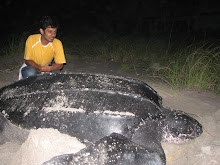
Facts About Sea-Turtles:
Anatomy:
Sea-Turtle A Journey:
After about 30 years of maturing, adult female sea turtles return to the land to nest at night, usually on the same beach from which they hatched. This can take place every two to four years in maturity. They make from four to seven nests per nesting season.
All sea turtles generally employ the same methods when making a nest. A mature nesting female hauls herself onto the beach until she finds suitable sand on which to create a nest. Using its hind flippers, the female proceeds to dig a circular hole 40 to 50 centimeters deep. After the hole is dug, the female then starts filling the nest with eggs one by one until it has deposited around 150 to 200 eggs, depending on the turtle's species. The nest is then re-filled with loose sand by the female, re-sculpting and smoothening the sand over the nest until it is relatively undetectable visually. The whole process takes around thirty minutes to a little over an hour. After the nest is laid, the female then returns to the ocean.
Some of the eggs are unfertilized 'dummy eggs' and the rest contain young turtles. Incubation takes about 2 months. The length of incubation and the gender of the hatchling depends on the temperature of the sand. Darker sands maintain higher temperatures, decreasing incubation time and increasing the frequency of female hatchlings. When the eggs hatch, these baby turtles dig their way out and seek the ocean. Only a very small proportion of them (usually .001%) will be successful, as many predators wait to eat the steady stream of new hatched turtles (since many sea turtles lay eggs en masse, the eggs also hatch en masse).
The hatchlings then proceed into the open ocean, borne on oceanic currents that they often have no control over. While in the open ocean, it used to be the case that what happened to sea turtle young during this stage in their lives was unknown. However in 1987, it was discovered that the young of Chelonia mydas and Caretta caretta spent a great deal of their pelagic lives in floating sargassum beds - thick mats of unanchored seaweed floating in the middle of the ocean. Within these beds, they found ample shelter and food. In the absence of sargassum beds, turtle young feed in the vicinity of upwelling "fronts" In 2007, is was verified that green turtles hatchlings spend the first three to five years of their lives in pelagic waters. Out in the open ocean, pre-juveniles of this particular species were found to feed on zooplankton and smaller nekton
before they are recruited into inshore seagrass meadows as obligate herbivores.
The Significance of these Turtles:
1. These Turtles feed on the sea-weeds in the coral reefs ensuring the fishes to lay eggs in such reefs.
2. To maintain the stability of the marine ecosystem
3. They migrate across the worlds oceans thereby indicating the ocean wealth of different regions
These are a few important functions which these turtles perform.
Classification:
Seven distinct species of sea turtles grace our oceans today; they constitute a single radiation that was distinct from all other turtles at least 110 million years ago. During that radiation, sea turtles split into two main subgroups, which still exist today: the unique family Dermochelyidae, which consists of a single species, the leatherback; and the six species of hard-shelled sea turtle, in the family Cheloniidae.
- Family Cheloniidae
Chelonia mydas
Eretmochelys imbricata
Natator depressos
Caretta caretta
Lepidochelys kempi
Lepidochelys olivaceae
- Family Dermochelyidae
Join TREE Foundation in this venture and make a difference to save this world. Inspired by Dr.Jane Goodal's Roots & Shoots Dr. Supraja Dharini Started TREE Foundation. The TREE Foundation has been involved in sea-turtle conservation and various other environmental awareness program. We have been organizing various programs such as Coastal cleanup, peace march, sapling plantation, educational trips for coastal village students to Vandalur zoo and Vedanthangal bird sanctuary.
We invite you to participate in an effort to establish a harmonious co-existence.
http://www.treefoundationindia.org/
Contact Info: Dr. Supraja Dharini, Arun krishnamurthy
krishnamurthyc18@gmail.com
arunoogle@gmail.com
9959977382
